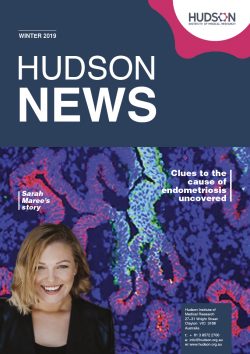Endometriosis is a debilitating disease affecting one in 10 women, but its cause is unknown and there is no cure.
Sadly, many women with endometriosis experience infertility and, despite many suffering crippling pain, it takes on average seven to 10 years for a diagnosis. Besides the financial and emotional cost to patients and their families, endometriosis costs Australia around $5 billion in lost productivity and around $2.5 billion in healthcare every year.

Hudson Institute’s world-leading endometrial stem cell expert, Professor Caroline Gargett, has discovered that highly regenerative cells called endometrial epithelial progenitor cells could lead to the abnormal cell growth in endometriosis.
In a study published in the journal Human Reproduction, Prof Gargett and collaborators from the UK examined endometrial samples from 102 women, and found that women with endometriosis had endometrial epithelial progenitor-like cells mixed with cells in the part of the womb lining that is shed during menstruation.
“These progenitor-like cells come from a deeper basal layer in the endometrium and generally shouldn’t be shed during menstruation. These are highly regenerative cells so it’s entirely possible that, in the wrong place, they could initiate endometriosis lesions,” Prof Gargett said.
“We believe that these cells may be related to an endometrial epithelial progenitor cell we discovered in the endometrium several years ago. Together, they could form an important piece of the endometriosis puzzle, helping us understand the complexity of the progenitor cells in the endometrium and their likely role in endometriosis.”
While this brings researchers closer to understanding how the endometrium works, more research is needed to find out the actual cell of origin for endometriosis. Hudson Institute research is seeking to generate this knowledge so new targeted treatments can be developed for patients.
World-renowned expert
Prof Gargett leads the Endometrial Stem Cell Biology Group at Hudson Institute. In 2004, she made the world-first discovery of two different stem cells in the endometrium. Her research aims to determine the role of stem cells in the development of endometriosis so that non-hormonal treatments can be developed to prevent or halt the disease.
In 2017, Prof Gargett’s team discovered that a protein called N-cadherin could be used as a marker to identify and isolate endometrial epithelial progenitor cells in the uterus. The discovery has meant that scientists can now investigate the role of these adult stem cells in conditions such as endometrial cancer, endometriosis, adenomyosis and Asherman’s syndrome, which are not well understood.
Collaborators: University of Liverpool, UK
Help us find new solutions for women with endometriosis
“It’s everyone’s problem when we have this many women suffering. Earlier diagnosis would really help – but funding is needed to progress research and new treatments.” SARAH MAREE CAMERON
ENDOMETRIAL EPITHELIAL PROGENITOR CELLS
Endometrial epithelial progenitor cells are types of adult stem cells found in the lining of the uterus
or womb that are responsible for maintaining the tissue. They can divide and renew themselves and also differentiate to form more mature cells of the tissue.
WHAT IS ENDOMETRIOIS?
A condition that affects women of reproductive age. It occurs when cells that line the uterus (or endometrium) grow in other parts of the body, usually the pelvic cavity.
These endometrial cells may stick to organs such as the ovaries, fallopian tubes, peritoneal lining, bowel or bladder, where they may grow to form patches, plaques, lesions or cysts.
Endometriosis lesions have also been discovered on the heart, knee and brain.
Although these cells are not in the uterus, they are still responsive to the female reproductive hormone oestrogen and may bleed during menstruation, causing inflammation, internal bleeding and scar tissue.
WHAT IS ADENOMYOSIS?
A condition where cells that normally line the uterus also grow in the muscle wall of the uterus.
BANNER TISSUE IMAGE | shows the location of human endometrial epithelial progenitor cells deep in the uterine lining. There are two types: the most primitive epithelial progenitor cells (red and blue) and more mature epithelial progenitor cells (green and blue). These progenitors produce the fully matured gland cells that provide nutrition to the implanting embryo and nourish it for the early weeks of pregnancy as the placenta develops.
-
Previous
Director’s message -
Next
Sarah Maree’s story

